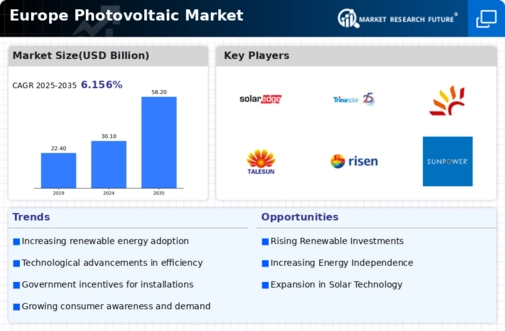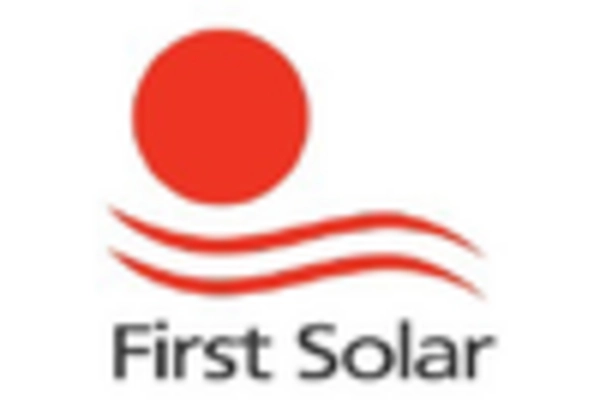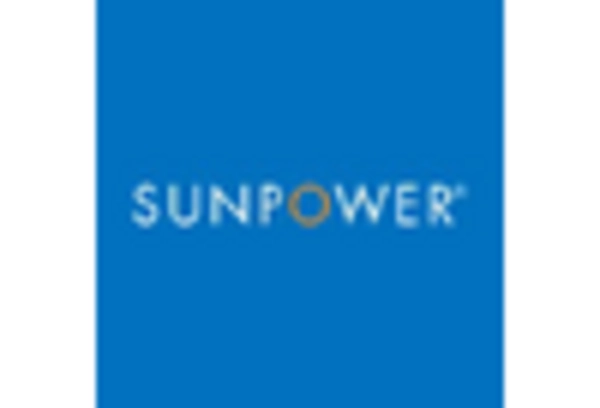Germany : Strong Policies Drive Market Growth
Germany holds a commanding 7.5% market share in the European photovoltaic sector, valued at approximately €20 billion. Key growth drivers include robust government incentives, such as the Renewable Energy Sources Act (EEG), which promotes solar energy adoption. Demand trends show a significant increase in residential solar installations, supported by favorable financing options and a growing awareness of sustainability. Infrastructure improvements, including grid enhancements, further bolster market potential.
UK : Government Support Fuels Growth
The UK photovoltaic market accounts for 3.8% of the European share, valued at around €10 billion. Growth is driven by government initiatives like the Feed-in Tariff and Contracts for Difference, which incentivize solar energy projects. Demand is rising in urban areas, particularly in London and Manchester, where energy costs are high. The market is also witnessing a shift towards community solar projects, enhancing local energy resilience.
France : Diverse Applications and Incentives
France's photovoltaic market holds a 4.2% share, valued at approximately €11 billion. The growth is propelled by the Multiannual Energy Program (PPE), which sets ambitious solar capacity targets. Demand is particularly strong in regions like Occitanie and Provence-Alpes-Côte d'Azur, where solar farms are proliferating. The competitive landscape features major players like TotalEnergies and EDF Renewables, focusing on both utility-scale and residential installations.
Russia : Potential in Vast Landscapes
Russia's photovoltaic market represents 2.5% of the European share, valued at around €6 billion. Key growth drivers include government support through the Renewable Energy Law, which encourages investment in solar projects. Demand is increasing in regions like Krasnodar and Tatarstan, where solar potential is high. The market is competitive, with local players like Hevel and international firms like JinkoSolar establishing a presence.
Italy : Strong Demand and Innovation
Italy captures a 2.8% market share in Europe, valued at approximately €7 billion. The growth is fueled by the Conto Energia program, which incentivizes solar installations. Demand is particularly strong in sunny regions like Sicily and Apulia, where residential and commercial solar projects are booming. The competitive landscape includes major players like Enel Green Power and Canadian Solar, focusing on innovative solutions and energy storage.
Spain : Revitalized Market Opportunities
Spain holds a 1.8% share of the European photovoltaic market, valued at around €5 billion. The growth is driven by the new Renewable Energy Auction system, which has revitalized solar investments. Demand is particularly high in Andalusia and Extremadura, where solar farms are expanding rapidly. The competitive landscape features key players like Fotowatio Renewable Ventures and Trina Solar, focusing on large-scale projects and grid integration.
Rest of Europe : Diverse Markets with Unique Challenges
The Rest of Europe accounts for a mere 0.2% of the photovoltaic market, valued at approximately €500 million. Growth is hindered by varying regulatory frameworks and market maturity across countries. Demand is emerging in smaller markets like the Baltics and Balkan regions, where local initiatives are beginning to take shape. The competitive landscape is fragmented, with local players dominating and international firms exploring niche opportunities.


















Leave a Comment